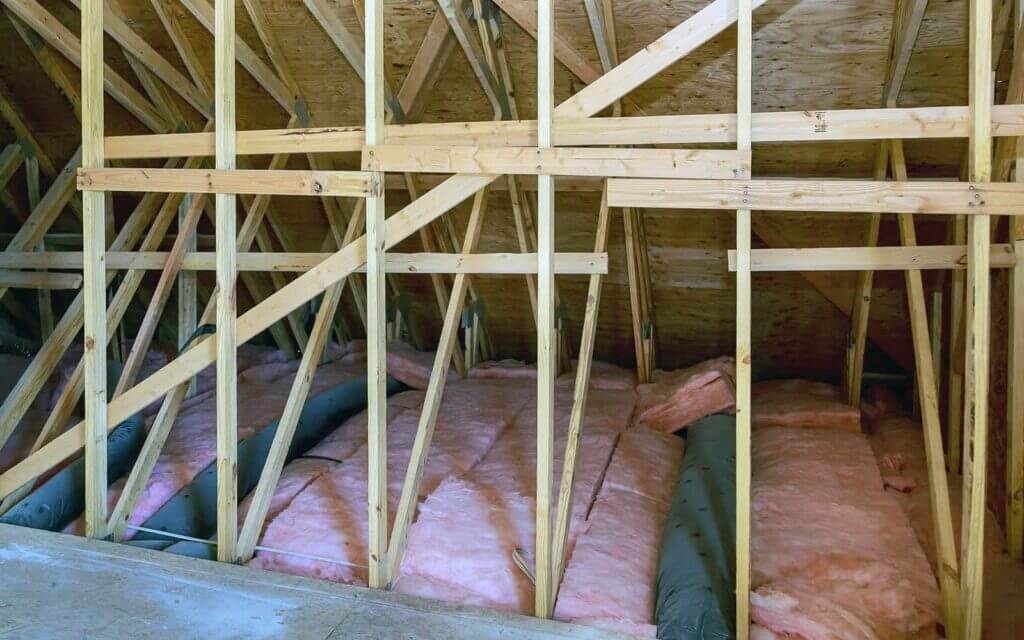It’s important to know the blown in attic insulation pros and cons before making your decision. Take a look at what every homeowner should know about blown-in insulation.
Table of Contents
- Advantages of Blown-In Attic Insulation
- Disadvantages of Blown-In Attic Insulation
- Insulation Upgrade: Final Thoughts
- FAQ
Advantages of Blown-In Attic Insulation
Let’s start with the advantages of blown-in attic insulation. We think you’ll find that it is a solid choice and might just be exactly what you’re looking for.
Best Option If You’re Not Doing a Renovation Project
If you don’t want to have to tear down walls to add insulation, blown-in is the way to go. Using the batt “blanket” insulation that’s commonly used in new constructions would mean having to tear down drywall in order to get between the wall studs and ceiling joints.

With blown-in insulation, you’re literally blowing the insulation into existing spaces. That makes it a low-hassle project with a big impact.
Gets Between Tight Spaces
If your home is mysteriously drafty, there’s a good chance that it has small gaps and spaces where insulation isn’t doing its job.
Blown-in insulation has the unique ability to seal little gaps to stop cold air in its tracks.
When you’re really conscientious about saving energy and saving money on your utility bills, blown-in insulation gets the job done.
Good R-Value
Typical blown-in fiberglass insulation has an R-value of between 2.2 and 2.7 per inch. In the insulation world, a product’s R-value is the rating assigned to indicate resistance to conductive heat flow. R-value is essentially thermal resistance that directly impacts your home’s energy efficiency.
Noise Reduction
This is a little-known perk of adding blown-in insulation! Yes, blown-in insulation actually has noise-proofing properties that help to reduce the transfer of sounds between your home and the outside. Insulation can make a big difference if you’re within earshot of a busy road or highway.
Affordable Installation
Blown-in insulation is priced comparably to other insulation options. However, you can enjoy cost savings when it comes to installation because this is a much easier product to install in a home when compared to other options that require contractors to place sheets of insulation.
Some homeowners do choose to install blown-in insulation on their own. While feasible, this can be a tough task to do if you don’t have experience. The time and cost involved with assembling materials and renting a blower can sometimes be too much to justify a do-it-yourself approach to adding more insulation.
Use an attic insulation estimator to plug in the area width, area length and desired R-value to get an idea of project cost.
More Comfortable Indoor Environment
With blown-in attic insulation, you can have a better relationship with your thermostat. Blown-in insulation is known to lock in cooler temperatures during the hot summer months. In the winter, it stops air from leaking out.
That means that you’re able to control indoor air temperatures without much variance. Many homeowners find that the annoying problem of “hot” and “cold” spots within a home go away!
Reduced Energy Costs
The same properties of blown-in insulation that create a more comfortable, predictable indoor environment also reduce energy costs.

Blown-in insulation seals even the smallest of cracks that allow air to leak out. This can create massive savings in energy costs over the years. Don’t be surprised if your insulation more than pays for itself in just a couple of years.
In fact, this is the biggest reason behind why so many people upgrade their insulation using blown-in insulation.
Fire Protection
If you opt for blown-in insulation made from fiberglass or cellulose, you’re potentially adding fire protection to your home. That’s because these materials help to create an airtight seal in your home that prevents air from flowing through tiny spaces that will stoke the flames of a fire.
Mold and Mildew Prevention
Blown-in insulation is great for reducing condensation in your home.
The benefit to this is that you’ll keep moisture out of your attic. This can be a life-changing thing for homeowners who are constantly dealing with mold and mildew.
The anti-condensation properties of blown-in insulation may also help to preserve the life of your roof by creating a better moisture barrier for preventing rot.
Disadvantages of Blown-In Attic Insulation
While there are plenty of positive things to say, let’s not fail to acknowledge some of the drawbacks when discussing blown-in attic insulation pros and cons. It’s not perfect by any means, but it’s definitely a solid candidate.
Creates Noticeable Plugs
This one is more of an aesthetic concern. When blown-in insulation is added, small holes are drilled into the tops of your stud spaces on the exterior of your home. While this is a much less invasive option than insulation that requires you to tear down drywall, it will leave behind marks.
Small plugs will be left in your siding where the holes were drilled. The plugs will be matched to blend into your existing siding color. While the plugs are usually camouflaged, they can be more obvious with certain siding types.
Gaps Are Possible
While blown-in insulation is great at filling in gaps, it’s not foolproof. Gaps may be left behind if there are any obstructions in the wall. Gaps are commonly created by things like outlet boxes and drainpipes. Even boards that were added for stability when a house was built can create blockages that lead to gaps.
Slight Settling
Blown-in insulation can settle a few inches as the years go on.
While this isn’t considered a big deal, it will slightly reduce the R-value (thermal resistance) of your insulation. Your home will not be as energy efficient as it once was when you first installed the insulation.
This may be a deal-breaker for some, but keep in mind that this settling happens over years, not weeks or months.
Insulation Upgrade: Final Thoughts
The blown-in attic insulation pros and cons showcase just how beneficial this option can be for a homeowner when compared to other insulation options. It’s obvious that blown-in insulation can help you to create a safer, more comfortable home with reduced energy costs!
There isn’t an easier option if you want to reduce energy costs at your home using better insulation. A quick process, installation won’t require you to tear down walls, restructure anything in your home or do tons of preparation. In fact, the process will be complete in just a few hours if you bring in an insulation expert to get the job done for you. That one day of work will lead to years and years of energy savings at your home!
Blown-in attic insulation is a top option if you’re looking for energy savings and peace of mind without a huge financial investment. The energy savings begin when you get an estimate!
FAQ
What is the R-value of blown-in attic insulation?
Blown-in fiberglass insulation typically has an R-value between 2.2 and 2.7 per inch. The R-value measures the thermal resistance, which impacts your home’s energy efficiency.
Can I install blown-in insulation myself?
While it’s possible to install blown-in insulation yourself, it can be a challenging task without experience. The time and cost involved in assembling materials and renting a blower can sometimes justify hiring a professional.
Does blown-in insulation reduce noise?
Yes, blown-in insulation has noise-proofing properties that help reduce sound transfer between your home and the outside environment, making it quieter indoors.
Is blown-in insulation fire-resistant?
Blown-in insulation made from fiberglass or cellulose can add fire protection to your home by creating an airtight seal that prevents air from flowing through small spaces and stoking flames.
How does blown-in insulation prevent mold?
Blown-in insulation reduces condensation and keeps moisture out of your attic, preventing mold and mildew growth and preserving the life of your roof.
Is blown-in insulation cost-effective?
Blown-in insulation is usually more affordable than other options and offers significant energy savings over time, often paying for itself in just a few years.
Ready to Upgrade Your Attic Insulation?
If you’re ready to enjoy a quieter, more energy-efficient home, consider upgrading to blown-in attic insulation. Contact Texas Made Windows and More today for a consultation and start experiencing the benefits of high-quality insulation.
